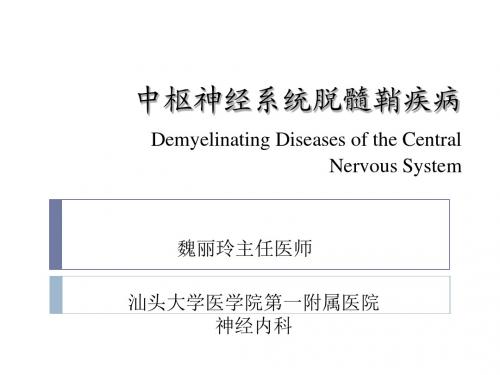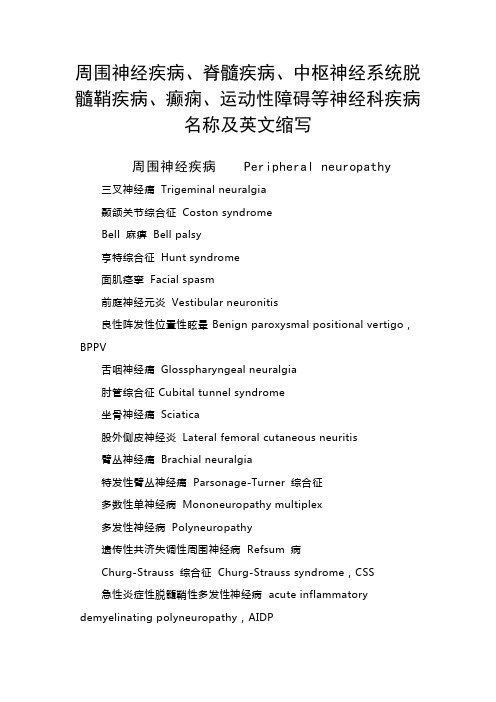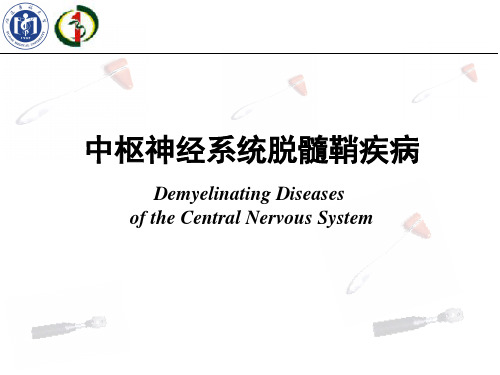中枢神经系统脱髓鞘疾病英文
中枢神经系统脱髓鞘疾病PPT课件

• 放射性脑病或化疗后的脑部后遗症 • 某些累及深部灰质团的疾病:
• MR 所见 整个脊髓自上颈段至腰段圆锥均已包 括。T1WI显示脊髓的轮廓、外形和信号均无明显 异常。但T2WI脊髓胸段及胸腰交界段,相当腰膨 大处等均有条状及大片状高信号影,TA切面T2WI 显示脊髓中央区呈高信号。T1WI亦见中央区信号 较低
• 诊断 结合临床,可以符合脊髓多发性硬化症
15
16
33
典型病例
• 女性,5岁。 “感冒”发烧,体温39.50 C,四肢震顫,言语不清3天
• MR 征象 两側基底节区,两側顶叶后部, 两側小脑深部等处,有大小不等的片状 T1WI低信号,T2WI高信号影,无明显的占 位效应
• 诊断 结合病史和临床表现,可诊断 ADEM
34
35
36
37
38
39
4
多发性硬化 (Multiple Sclerosis)
• 本病常见,多பைடு நூலகம்生于20~40岁,女性更多见。 临床常有多次发作史,表现为痉挛性共济失调
• 基本病理 散在于大脑、小脑、脊髓和神经,尤其 颅神经的局限性 脱髓鞘改変
• MR 征象 常见为脑室周围和小脑白质内橢圆形 界限较清晰的长T1和长T2影,直径可长达2cm。 增强扫描 急性期病灶可有轻~中度强化,慢性 期病灶一般不强化。还可有脑萎缩
• 增强扫描 病灶多无明显强化,或仅有轻~中度强化
脱髓鞘疾病

2. 运动障碍 皮质脊髓束损害 引起痉挛性瘫痪 (spastic paralysis: 偏 瘫 hemiplegia, 截 瘫 paraplegia, 单瘫 monoplegia)
运动障碍多数为轻瘫且常左右不对称, 运动障碍多数为轻瘫且常左右不对称 上 下肢瘫痪程度多不均等, 下肢瘫痪程度多不均等 下肢受累比上肢 常见。检查时可见肌张力增高, 常见。检查时可见肌张力增高 腱反射亢 腹壁反射消失, 病理反射阳性。 进, 腹壁反射消失 病理反射阳性。
辅助检查 1. 脑脊液(cerebrospinauid, CSF) 脑脊液 常规和生化: 外观及压力正常, 常规和生化 外观及压力正常 总蛋白量正常 或轻度增高 免疫学检测: 鞘内合成(CSF-IgG指数大于 免疫学检测 IgG鞘内合成 鞘内合成 指数大于 0.7; 24小时 小时IgG合成率增高 CSF寡克隆 合成率增高; 寡克隆IgG 小时 合成率增高 寡克隆 阳性。髓鞘碱 带, 即oligoclonal band, OB, 阳性 髓鞘碱 性蛋白(MBP)增高提示 活动 增高提示MS活动 性蛋白 增高提示
根据分子模拟学说, 根据分子模拟学说, 病毒感染与 MS 的关系主 要是因为HHV要是因为HHV-6及EBV基因序列中有一些部分 EBV基因序列中有一些部分 HHV与髓鞘中的成分相似 (如 HHV-6 中一段序列中 7个氨基酸与MBP的完全相同), 当HHV-6或 个氨基酸与MBP的完全相同 的完全相同), HHVEBV感染后 激活T淋巴细胞, 被病毒激活的T EBV感染后, 激活T淋巴细胞, 被病毒激活的T 感染后, 细胞误将髓鞘作为病毒进行攻击, 细胞误将髓鞘作为病毒进行攻击, 从而导致自 身免疫性反应. 身免疫性反应.
7. 其他 一些发作性症状, 一些发作性症状 以痛性强直痉挛性发作及 瘙痒多见。该症状是一突发短暂呈破伤风 瘙痒多见。 样强直痉挛或类似手足搐搦样发作, 样强直痉挛或类似手足搐搦样发作 向下或 向上迅速扩散常作剧烈疼痛或感觉障碍, 向上迅速扩散常作剧烈疼痛或感觉障碍 一 般认为是因CNS部分髓鞘脱失的病变中 运 部分髓鞘脱失的病变中, 般认为是因 部分髓鞘脱失的病变中 动传导束的神经冲动向周围扩散所引起的。 动传导束的神经冲动向周围扩散所引起的。
√中枢神经系统脱髓鞘疾病

髓 鞘 构 成
CNS
少突胶质细胞
施旺氏细胞
PNS
脱髓鞘影象
脱髓鞘的病理特点
神经纤维髓鞘破坏呈多发性小的播散性病灶
病损分布于CNS白质,小静脉周围炎细胞浸润
神经细胞、轴突及支持组织结构完整
临床常见脱髓鞘疾病
多发性硬化症(multiple sclerosis, MS) 亚型视神经脊髓炎( Devic diseases )
②感觉异常:肢体、躯干或面部针刺麻木感,异常的 肢体发冷、蚁走感、瘙痒感及尖锐烧灼样痛,定位不 明确。 ③眼部症状:单眼视力下降,有时双眼同时受累;眼 肌麻痹及复视;眼球震颤;一个半综合症 ④共济失调:Charcot三主征(眼震、意向性震颤、吟 诗样言语)
眼球震颤
4.临床症状和体征
多发性硬化的临床分型
临床分型 复发缓解型MS 临床表现 最常见,80%-85%的MS患者最初表现为复发缓解病程,以 神经系统症状急性加重,伴完全或不完全缓解为特征 大约为50%的RR-MS患者在发病约10年后,残疾持续进展, 伴或不伴复发,不完全缓解 约占10%,发病时残疾持续进展,且持续至少1年,无复发 约占5%,发病时残疾持续进展,伴有复发和不完全缓解
4.临床症状和体征
⑥精神症状:多表现为抑郁、易怒、脾气暴躁。可出 现记忆力减退、注意力损害等认知功能障碍。 ⑦:其他症状:膀胱功能障碍、性功能障碍。 多发性硬化可合并风湿性、类风湿综合症、重症肌无 力、干燥综合征等。
六、临床分型
MS的分型与MS治疗决策有关
1、复发缓解(R-R)型 2、继发进展(S-P)型 3、原发进展(P-P)型 4、进展复发(P-R)型
继发进展型MS
中枢神经系统脱髓鞘疾病教学提纲

2020/8/21
嘻嘻
病因及发病机制
1.MS可能是CNS病毒感染引起的自身 免疫病。分子模拟学说(病毒与CNS髓 鞘素蛋白或少突胶质细胞存在共同抗原, 病毒氨基酸序列与神经髓鞘组分的多肽 序列相同或相近,病毒感染后体内T细 胞激活和产生抗病毒抗体,与神经髓鞘 多肽片段发生交叉反应引起脱髓鞘病 变)。
矢状位T1W:C1-4长T1信号,脊髓水肿
2020/8/21
2020/8/21
矢状位T2W:C1-4长T2信号
矢状位 T2W : C1高信号
2020/8/21
六、诊断标准 Poser(1983)诊断标准: 两次发作发作间隔必须是1个月以上, 每次发作超过24小时。 亚临床证据(subclinical)包括诱发电 位、CT/MRI发现病灶。
2020/8/21
脊髓 脑神经 脑干 小脑 半球
2020/8/21
四、临床分型
1.复发-缓解(R-R)型:临床最常见,约 2/3患者疾病早期出现多次复发和缓解, 可急性发病或病情恶化,之后可恢复, 两次复发间病情稳定。
2.继发进展SP型:约50%R-R型患者经过 一段时间可转为此型,进行性加重而不 再缓解,出现渐进性神经症状恶化,伴 或不伴有急性复发。
2020/8/21
大体尸检 标本两侧 内囊有脱 髓鞘病变
2020/8/21
MS病人死 后大体尸 检标本镜 下示硬化 斑块
2020/8/21
2020/8/21
病理:病 变中央区 广泛软化 坏死
临床表现
发病年龄10-60岁,以20-40岁者多见。 我国报道1例经尸检证实为MS者仅1岁半, 尸检证实年龄最大64岁。女性患者略高 于男性。国内统计,女:男为1.04-2.1: 1。
中枢神经系统脱髓鞘疾病英文

Clinical research cooperation
要点三
Regular physical examinations
Regular physical examinations are conducted, especially for individuals with a family history, in order to detect potential demyelinating diseases at an early stage.
Transplantation surgery
Transplanting healthy nerve tissue to the damaged area to promote nerve regeneration and repair.
Other treatment methods
Physical therapy
03
Psychological adjustment
Patients should maintain a positive and optimistic attitude, learn to regulate their emotions, and reduce the impact of anxiety and depression on the disease.
Through surgery, the pressure on nerve tissue caused by lesions is reduced, improving nerve function.
Excision surgery
The removal of diseased tissue to eliminate the cause and alleviate symptoms.
中枢神经系统脱髓鞘疾病

核间性眼肌麻痹
⑷.共济失调
30%-40%患者有共济运动障碍; Charcot三联征(眼震、意向震颤、 吟诗样语言)见于晚期MS
⑸.发作症状 持续时间短暂、可被 特殊因素诱发的感觉或运动异常 MS的特征性症状之一 频繁过度换气、焦虑、肢体维持 某种姿势可诱发 常见表现: 强直痉挛;感觉异常;构音障碍; 共济失调;疼痛不适
⑷.硫唑嘌呤
⑸.醋酸格拉太咪尔 ⑹.造血干细胞移植
2.继发进展型MS的治疗 皮质类固醇治疗无效 ①免疫抑制剂
氨甲喋呤 环磷酰胺 环孢霉素A
3.原发进展型MS的治疗
特异性免疫调节治疗无效
主要是对症治疗
4.对症治疗
保证足够的休息,避免过劳
金刚烷胺 0.1 早、中各1次
预后
提示预后良好的因素: 女性;40岁以前发病; 以感觉症 状为主要表现 病程为进行性者预后最差
Lhermitte sign(莱尔米特征)
⑹.精神症状 抑郁、易怒、脾气暴躁;欣快、兴 奋;淡漠、强哭强笑、反应迟钝; 记忆减退、认知障碍
⑺.其他症状
膀胱功能障碍;男性患者性功能障碍
可伴有其它自身免疫性疾病
风湿病;类风湿综合征;MG
MS的临床分型
1.复发缓解型 2.继发进展型 3.原发进展型 4.进展复发型
VEP
BAEP SEP
3.MRI 分辨率高,可识别无临床症状的病 灶,使MS诊断不再只依赖临床标准 CNS白质内多发的、大小不一的病 灶,最常分布在侧脑室周围 MS斑块表现为T1低信号、T2高信号
临床诊断标准
1.从病史和神经系统检查,表明中枢神经系 统白质内同时存在两处以上的病灶; 2.起病年龄在10-50岁之间;
中枢神经系统脱髓 鞘疾病
中枢神经系统脱髓鞘疾病概述

诊断分类
诊断标准(符合其中1条)
临床可能MS(Clinical probable MS,CPMS)
1病程中两次发作,一处病变临床证据
2病程中一次发作,两个分离部位病灶 的临床证据
3病程中一次发作,一处病变临床证据 和另一处病变亚临床证据。
实验室检查支持可能
病程中两次发作, CSF-OB/IgG,两次
多发性硬化的诊断标准 (Poser1983)
诊断分类
诊断标准(符合其中1条)
临床确诊MS(Clinical definite MS,CDMS)
1病程中两次发作和两个分离病灶的临床 证据
2病程中两次发作,一处病变临床证据和 另一处病变亚临床证据。
实验室检查支持确诊
1病程中两次发作,一处临床或亚临床证
临床表现
感觉异常 — 浅感觉 定位不明确
— 深感觉 — Lhermitte征
共济失调 — 我国 30%-40%,西方 70%-80%
— Charcot 三主征 部分晚期MS患者 眼球震颤、意向性震颤、吟诗样语言
临床表现
自主神经功能障碍
直肠、膀胱、性功能障碍 不单独出现
精神症状和认知功能障碍 — 精神症状:抑郁、暴躁、兴奋等
1次发作
MRI显示病灶在时间上的多发性
临床证据提示2个以上不同 (增强后)
部位病灶
鉴别标准
急性播散性脑脊髓炎 — 急性炎症性脱髓鞘性病变,患者多有前驱感染 或疫苗接种史 — 好发于儿童 — 起病急且凶险,可有发热、脑膜炎、意识障碍 — 球后视神经炎少见 — 无缓解复发
鉴别标准
系统性红斑狼疮 —神经系统可损害脑、脊髓、周围神经 —有神经系统以外表现,发热、关节痛,面部蝶 形红斑,心脏、肺、肾脏、血液、消化系统多系统 损害 — 血抗核抗体(ANA)、抗双链DNA(ds-DNA)抗 体等阳性,血清总补体及C3、C4降低
中枢神经系统脱髓鞘疾病

2020/11/14
2
多发性硬化(multiple sclerosis,MS)是以中枢
神经系统(CNS)白质脱髓鞘病变为特点, 遗传易感个体与环境 因素作用发生的自身免疫病。 CNS散在分布的多数病灶与病程
中呈现的缓解复发,症状和体征的空间多发性和病程的时间多 发性构成了MS的主要临床特点。由于发病率较高, 呈慢性病 程和倾向于年轻人罹患, 估计目前世界范围内年轻的MS患者 约有100万人。
2020/11/14
10
【临床分型】
根据病程, MS被分为以下五型,该分型与MS的治疗决策有关 MS与治疗决策有关的临床病程分型
病程分型
复发-缓解(R-R)型MS
继发进展(SP)型MS
原发进展型MS 长
进展复发型MS 良性型MS
临床表现
临床最常见,约占85℅,疾病早期出现多次复发和缓解稳定。
(2)约半数病例可见视力障碍,自一侧开始,隔一段时间再侵 犯另一侧,或短时间内两眼先后受累。发病较急,常有缓解 – 复发,可于数周后开始恢复;
2020/11/14
7
(3)眼球震颤多为水平性或水平加旋转,复视约占1/3。病变 侵犯内侧纵束引起核间性眼肌麻痹,侵犯脑桥旁正中网状结构 导致一个半综合征;其他脑神经受累少见,如中枢性或周围性 面瘫,耳聋、耳鸣、眩晕、咬肌力弱、构音障碍和吞咽困难等; (4)半数以上患者出现感觉障碍,包括深感觉障碍和Romber g征。 (5)约半数病例可见共济失调。 (6)神经电生理检查证实, MS可合并周围神经损害如(多发 性神经病、多发性单神经病)可能因周围神经PI蛋白与中枢神 经系统的MBP为同一组分,均发生脱髓鞘所致; (7)可出现病理性情绪高涨如欣快和兴奋,多数病例表现抑郁 、易怒,也可见淡漠、嗜睡、强哭强笑、反应迟钝、重复语言、 猜疑和迫害妄想等精神障碍。
中枢神经系统脱髓鞘疾病

另一特殊的感觉障碍为Lhermitte征,即 屈颈时,出现自后颈部向下、向背和四 肢放射的短暂性电击样麻痛感。由于颈 髓后索损害引起。
4.共济失调(ataxia):(小脑功能受损)
病变累及小脑或脑干小脑通路时,可引 起意向性震颤,步态不稳,言语障碍。意 向性震颤、眼球震颤和吟诗样言语即构成 夏科氏三联征(Charcot)。过去曾被认 为是MS的主要表现,实际上仅占MS的 10-15%。
外观正常,压力正常,总蛋白量正常或 轻度增高。
检测IgG鞘内合成:CSF-IgG指数大于 0.7;24小时IgG合成率增高;CSF寡克隆 IgG带( oligoclonal band, OB)
髓鞘碱性蛋白(MBP)增高提示MS活 动。
2.诱发电位(evoked potentials)检查: 包括视觉诱发电位( visual EP, VEP)、 脑干听觉诱发电位( brainstem auditory EP, BAEP)和体感诱发电位 (somatosensory EP, SEP),
1924年夏,医生断定7年前脊椎受过暗伤, CNS受到严重损害
1927年双腿瘫痪,右手还能活动,右眼 发炎,接着左眼也感染了,6月后双目失 明
1936年肾病加剧逝世
胼胝体的类圆形斑块,脑干、小脑和脊 髓的斑点状不规则斑块,呈长T1长T2; (3)多数病程长的患者可伴有脑室系统 扩张、脑沟增宽等脑白质萎缩征象。
头部T2W:长T2信号
头部矢状位T2W:长T2信号
头部T1W:长T1信号
头部T2W:头部长T2信号
脑萎缩,长T1信号
脑萎缩,长T2信号
脑萎缩, 长T2信号
脊髓横贯性损害或圆锥马尾部病变时, 可引起二便及性功能障碍。早期为尿频、 尿急,尿潴留,便秘等,以后形成自动 膀胱,表现为尿失禁。
周围神经疾病、脊髓疾病、中枢神经系统脱髓鞘疾病、癫痫、运动性障碍等神经科疾病名称及英文缩写

周围神经疾病、脊髓疾病、中枢神经系统脱髓鞘疾病、癫痫、运动性障碍等神经科疾病名称及英文缩写周围神经疾病Peripheral neuropathy 三叉神经痛Trigeminal neuralgia颞颌关节综合征Coston syndromeBell 麻痹Bell palsy亨特综合征Hunt syndrome面肌痉挛Facial spasm前庭神经元炎Vestibular neuronitis良性阵发性位置性眩晕 Benign paroxysmal positional vertigo,BPPV舌咽神经痛Glosspharyngeal neuralgia肘管综合征 Cubital tunnel syndrome坐骨神经痛Sciatica股外侧皮神经炎Lateral femoral cutaneous neuritis臂丛神经痛Brachial neuralgia特发性臂丛神经痛Parsonage-Turner 综合征多数性单神经病Mononeuropathy multiplex多发性神经病Polyneuropathy遗传性共济失调性周围神经病Refsum 病Churg-Strauss 综合征Churg-Strauss syndrome,CSS急性炎症性脱髓鞘性多发性神经病acute inflammatory demyelinating polyneuropathy,AIDP吉兰-巴雷Guillain Barre syndrome,GBS急性运动轴索性神经病Acute motor axonal neuropathy,AMAN 急性运动感觉轴索性神经病Acute motor-sensory axonal neuropathy,AMSANMiller-Fisher 综合征 Miller-Fisher syndrome,MFS急性泛自主神经病Acute panautonomic neuropathy急性感觉神经病Acute neuropathy,ASN急性炎症性脱髓鞘性多发性神经病Chronic inflammatory demyelinating polyradiculoneuritis,CIDP感觉运动神经病Sensory motor neuropathy,SMNP脊髓疾病脊髓半切综合征 Brown-Sequard syndrome脊髓炎Myelitis脊髓病Myelopathy急性脊髓炎 Acute myelitis人类T 淋巴细胞病毒 1 型相关脊髓病HTLV-1 associated myelopathy,HAM亚急性坏死性脊髓炎Subacute necrotizing myelitis压迫性脊髓病Compressive myelopathy亚急性联合变性Subacute combined degeneration of spinal cord,SCD非恶性贫血型联合系统变性Combined systemic degeneration of non-pernicious anemia type脊髓空洞症Syringomyelia延髓空洞症Syringobulbia脊髓血管病Vasular disease of the spinal cord动静脉畸形Arteriovenous malformation,AVM脊髓间歇性跛行Intermittent claudication of the spinal cord 脊髓静脉高压综合征Venous hypertensive myelopathy,VHM 纤维软骨性栓塞Fibrocartilaginous embolism脑血管疾病 Cerebrovascular disease短暂性脑缺血发作Transient ischemic attack,TIA短暂性全面遗忘症Transient global amnesia,TGA脑梗死Cerebral infarction缺血性脑卒中Cerebral ischemic stroke延髓背外侧综合征Wallenberg syndrome闭锁综合征Locked-in syndrome基底动脉尖综合征Top of the basilar syndrome,TOBS脑栓塞Cerebral embolism心源性脑栓塞Cardiogenic cerebral embolism出血性梗死Hemorrhagic infarction,HI腔隙性脑梗死Lacunar infarction脑分水岭梗死Cerebral watershed infarction,CWSI边缘带梗死Border zone infarction脑出血Intracerebral hemorrhage,ICH脑淀粉样血管病Cerebral amyloid angiophthy,CAA蛛网膜下腔出血Subarachnoid hemorrhage,SAH颅内静脉系统血栓形成Cerebral venous thrombosis,CVT海绵窦血栓形成Cavernous sinus thrombosis上矢状窦血栓形成Superior sagittal sinus thrombosis侧窦血栓形成Lateral sinus thrombosis烟雾病Moyamoya脑盗血综合征Steal syndrome锁骨下动脉盗血综合征Subclavian steal syndrome颈动脉盗血综合征Carotid steal syndrome椎基底动脉盗血综合征Vertebrobasilar steal syndrome伴有皮质下梗死和白质脑病的常染色体显性遗传性脑动脉病(Cerebral autosomal dominant arteriopathy with subcortical infarcts and leukoencephalopathy,CADASIL)伴有皮质下梗死和白质脑病的常染色体隐性遗传性脑动脉病(Cerebral autosomal recessive arteriopathy with subcortical infarcts and leukoencephalopathy,CARASIL)动脉夹层Artery dissection原发性中枢神经系统血管炎Primary angitis of central nervous system,PACNS中枢神经系统肉芽肿性血管炎Gramulomatous angitis of the CNS,GACNS血管性痴呆Vascular dementia,VaD血管性认知功能障碍Vascular cognitive impairment,VCI多梗死性痴呆Multi-infarct dementia,MID皮质下血管性痴呆Subcortical vascular dementia关键部位梗死性痴呆Strategic infarct dementia中枢神经系统感染性疾病Central nervous system,CNS单纯疱疹病毒性脑炎Herpes simplex virus encephalitis,HSE单纯疱疹病毒Herpes simplex virus,HSV巨细胞病毒性脑炎Cytomegalovirus encephalitis,CMVE巨细胞病毒Cytomegalovirus,CMV病毒性脑炎 Virus encephalitis亚急性硬化性全脑炎Subacute sclerosing panencephalitis,SSPE进行性多灶性白质脑病Progressive multifocal leukoencephalopathy,PML化脓性脑膜炎Purulent meningitis结核性脑膜炎Tuberculous meningitis,TBM隐球菌性脑膜炎Cryptococcal meningitis朊蛋白病Prion disease朊蛋白PrionCreutzfeldt-Jakob 病Creutzfeldt-Jakob disease,CJD皮质-纹状体-脊髓变性Corticostriatal-spinal degeneration 亚急性海绵状脑病Subacute spongiform encephalopathy新变异型Creutzfeldt-Jakob 病New variance of Creutzfeldt-Jakob disease,nvCJDGerstmann-Straussler-Scheinker 病Gerstmann-Straussler-Scheinker,GSSKuru 病Kuru disease家族性致死性失眠症Fatal familial insomnia,FFI中枢神经系统寄生虫感染Central nervous system parasitic infection脑囊虫病Cerebral cysticercosis脑型血吸虫病Brain schistosomiasis脑型肺吸虫病Cerebral paragonimiasis脑型疟疾Cerebral malaria神经梅毒Neurosyphilis神经莱姆病Lyme disease钩端螺旋体病Leptospirosis中枢神经系统脱髓鞘疾病多发性硬化Multiple sclerosis,MS视神经脊髓炎Neuromyelitis optica,NMO视神经脊髓炎谱系疾病Neuromyelitis optica spectrum disorders,NMOSDs长节段横断性脊髓炎Longitudinally extensive transverse myelitis,LETM复发性孤立性视神经炎Recurrent isolated opticneuritis,RION 双侧视神经炎Bilateraloptic neuritis,BON急性播散性脑脊髓炎Acute disseminated encephalomyelitis,ADEM急性出血性白质脑炎Acute hemorrhagic leucoencephalitis,AHLE同心圆性硬化Concentric sclerosis渗透性脱髓鞘综合征Osmotic demyelination syndrome,ODS 脑桥中央髓鞘溶解症Central pontine myelinolysis,CPM脑桥外髓鞘溶解症Extrapontine myelinolysis,EPM可逆性后部白质脑病综合征Reversible posterior leukoencephalopathy syndrome,RPLS肾上腺脑白质营养不良Adrenoleukodystrophy,ALD异染性脑白质营养不良Metachromatic leukodystrophy,MLD 运动障碍性疾病Movement disorders帕金森病Parkinson’s disease,PD震颤麻痹Paralysis agitans肝豆状核变性Hepatolenticular degeneration,HLD威尔逊病Wilson’s disease,WD小舞蹈病Chorea minorSydenham 舞蹈病 Sydenham chorea亨廷顿病Huntington disease,HD肌张力障碍Dystonia原发性震颤Essential tremor,ET扭转痉挛Torsion spasm眼睑痉挛Blepharospasm口-下颌肌张力障碍Oromandibular dystonia痉挛性斜颈Spasmodic torticollis手足徐动症Athetosis书写痉挛Writer’s cramp多巴反应性肌张力障碍Dopa-responsive dystonia,DRD发作性运动障碍Paroxysmal dyskinesias迟发性运动障碍Tardive dyskinesia,TD僵人综合征Stiff-person syndrome抽动秽语综合征Multiple tics-coprolalia syndrome癫痫癫痫Epilepsy缺氧缺血性脑病Hypoxic ischemic encephalopathy,HIE不典型失神发作Atypical absences肌阵挛Myoclonus自动症Automatism痴笑性发作Gelastic seizure颞叶癫痫Temporal lobe epilepsy额叶癫痫Frontal lobe epilepsy枕叶癫痫Occipital lobe epilepsy顶叶癫痫Parietal lobe epilepsy症状性癫痫Secondary epilepsy癫痫持续状态Status epilepticus,SE偏侧惊厥-偏瘫-癫痫综合征Hemiconvulsion-hemiplegia-epilepsy syndrome,HHE 假性发作Pseudoseizures惊厥性晕厥Syncope连续部分性癫痫持续状态Epilepsia partialia continua,EPC边缘性癫痫持续状态Limbic status epilepticus头痛Headache偏头痛Migraine紧张型头痛Tension-type headache,TTH丛集性头痛Cluster headache三叉自主神经性头痛Trigeminal autonomic cephalalgias,TACs 药物滥用性头痛Medication-overuse headache,MOH低颅压性头痛Headache attributed to low cerebrospinal fluid pressure脑脊液漏头痛CSF fistula headache腰穿后头痛Post-dural puncture headache9、神经系统变性疾病 Neurodegenerative diseases运动神经元病Motor neuron disease,MND进行性肌萎缩Progressive muscular atrophy,PMA进行性延髓麻痹Progressive bulbar palsy,PBP原发性侧索硬化Primary lateral sclerosis,PLS肌萎缩侧索硬化Amyotrophic lateral sclerosis,ALS多灶性运动神经病Multifocal motor neuropathy,MMN 脊肌萎缩症Spinal muscle atrophy,SMA阿尔茨海默病Alzheimer’s disease,AD路易体痴呆Dementia with Lewy bodies,DLB额颞叶变性Frontotemporal lobar degeneration,FTLD 额颞叶痴呆Frontotemporal dementia,FTD语义性痴呆Semantic dementia,SD帕金森病痴呆Parkinson disease with dementia,PDD 帕金森综合征Parkinsonism多系统萎缩Multiple system atrophy,MSA纹状体黑质变性Striatonigral degeneration,SND橄榄脑桥小脑萎缩Olivopontocerebellar atrophy,OPCA 小脑性共济失调Cerebellar ataxia皮质基底节变性Corticobasal degeneration,CBD血管性帕金森综合征Vascular Parkinsonism,VP神经系统遗传性疾病遗传性共济失调Hereditary ataxia,HA常染色体显性小脑共济失调Autosomal dominant cerebella ataxia,ADCAFriedreich 共济失调Friedreich ataxia,FRDA脊髓小脑性共济失调Spinocerebellar ataxia,SCA遗传性痉挛性截瘫Hereditary spastic paraplegia,HSP神经纤维瘤病Neurofibromatosis,NF结节性硬化症Tuberous sclerosis,TS神经皮肤综合征Neurocutaeous syndrome脑面血管瘤病Encephalo-facial angiomatosis神经肌肉接头和肌肉疾病重症肌无力Myasthenia,MG周期性瘫痪Periodic paralysis低钾型周期性瘫痪Hypokalemic periodic paralysis高钾型周期性瘫痪Hyperkalemic periodic paralysis正常钾型周期性瘫痪Normokalemic periodic paralysis多发性肌炎Polymyositis进行性肌营养不良 Progressive muscular dystrophy,PMD强直性肌营养不良 Myotonic muscular dystrophy,DM先天性肌强直Myotonia congenita线粒体脑肌病伴高乳酸血症和卒中样发作Mitochondrial encephalomyopathy with lactic acidosis and stroke-like episodes,MELAS脂质沉积性肌病Lipid storage myopathy,LSM糖原贮积病Glucogen storage disease,GSD自主神经系统疾病雷诺病Reynaud’s disease红斑肢痛症Erythromelagia面偏侧萎缩症Hemifacial atrophy全身自主神经功能不全Pandysautonomia自发性多汗症Spontaneous hyperhidrosis进行性脂肪营养不良Progressive lipodystrophy副肿瘤神经综合征Paraneoplastic neurologicalsyndromes,PNSLambert-Eaton 肌无力综合征LEMS副肿瘤性小脑变性Paraneoplastic cerebellar degeneration,PCD副肿瘤性脑脊髓炎Paraneoplastic encephalomyelitis,PEM副肿瘤性感觉神经元病Paraneoplastic sensory neuronopathy,PSN边缘叶脑炎Limbic encephalitis,LE抗NMDA 受体脑炎Anti-NMDA receptor encephalitis亚急性运动神经元病Subacute motor neuronopathy,SMN。
中枢神经系统脱髓鞘疾病英文ppt课件

考评项目赋标准分,对照考评内容和 考评办 法对考 评项目 进行考 评,评 出各考 评项目 的考评 实际得 分,考 评类目 下各考 评项目 考评实 际得分 之和为 该考评 类目的 考评实 际得分
考评项目赋标准分,对照考评内容和 考评办 法对考 评项目 进行考 评,评 出各考 评项目 的考评 实际得 分,考 评类目 下各考 评项目 考评实 际得分 之和为 该考评 类目的 考评实 际得分
考评项目赋标准分,对照考评内容和 考评办 法对考 评项目 进行考 评,评 出各考 评项目 的考评 实际得 分,考 评类目 下各考 评项目 考评实 际得分 之和为 该考评 类目的 考评实 际得分
Diagnostic criteria
1. Clinical definite MS (CDMS): ① two times of attack and two lesions; ② two attacks, one lesion and one subclinical evidence;
考评项目赋标准分,对照考评内容和 考评办 法对考 评项目 进行考 评,评 出各考 评项目 的考评 实际得 分,考 评类目 下各考 评项目 考评实 际得分 之和为 该考评 类目的 考评实 际得分
boratory and other assistant Tests
1. CSF Test
1) Number of MNC<15 106/L
考评项目赋标准分,对照考评内容和 考评办 法对考 评项目 进行考 评,评 出各考 评项目 的考评 实际得 分,考 评类目 下各考 评项目 考评实 际得分 之和为 该考评 类目的 考评实 际得分
考评项目赋标准分,对照考评内容和 考评办 法对考 评项目 进行考 评,评 出各考 评项目 的考评 实际得 分,考 评类目 下各考 评项目 考评实 际得分 之和为 该考评 类目的 考评实 际得分
第8章 中枢神经系统脱髓

4.环境因素MS发病率随纬度增高而呈增 .环境因素MS发病率随纬度增高而呈增 加趋势,离赤道愈远发病率愈高,南北半 球皆然。MS高危地区包括美国北部、加拿 球皆然。MS高危地区包括美国北部、加拿 大、冰岛、英国、北欧、澳洲的塔斯马尼 亚岛和新西兰南部,患病率为40/10万或 亚岛和新西兰南部,患病率为40/10万或 更高。赤道国家发病率小于l 10万,亚洲 更高。赤道国家发病率小于l/10万,亚洲 和非洲国家发病率较低.约为5 10万。我 和非洲国家发病率较低.约为5/10万。间短暂、可被特殊因素诱发 (5)发作性症状:是指持续时间短暂、可被特殊因素诱发 的感觉或运动异常。发作性的神经功能障碍每次持续数秒 至数分钟不等.频繁、过度换气、焦虑或维持肢体某种姿 势可诱发,是多发性硬化特征性的症状之一。强直痉挛、 感觉异常、构音障碍、共济失调、癫痫和疼痛不适是较常 见的多发性硬化发作性症状。其中,局限于肢体或面部的 强直性痉挛,常伴放射性异常疼痛,亦称痛性痉挛,发作 时一般无意识丧失和脑电图异常。被动屈颈时会诱导出刺 痛感或闪电样感觉,自颈部沿脊柱放散至大腿或足部痛感或闪电样感觉,自颈部沿脊柱放散至大腿或足部-称 为莱尔米特征(Lherinlne s•gn),是因屈颈时脊髓局部的 为莱尔米特征(Lherinlne s•gn),是因屈颈时脊髓局部的 牵拉力和压力升高、脱髓鞘的脊髓颈段后索受激惹引起。
【病理】 病理】 多发性硬化的特征性病理改变是中枢神经系统 白质内多发性脱髓鞘斑块,多位于侧脑室周围, 伴反应性胶质增生,也可有轴突损伤。病变可累 及大脑白质、脊髓、脑干、小脑和视抻经。脑和 脊髓冠状切面肉眼可见较多粉灰色分散的形态各 异的脱髓鞘病灶.大小不一,直径1 20… 异的脱髓鞘病灶.大小不一,直径1~20…以半 卵圆中心和脑室周围,尤其是侧脑室前角最多见。 镜下可见急性期髓鞘崩解和脱失.轴突相对完好, 少突胶质细胞轻度变性和增生,可见小静脉周围 炎性细胞(单核、淋巴和浆细胞) 炎性细胞(单核、淋巴和浆细胞)浸润。病变晚期 轴突崩解,神经细胞减少.代之以神经胶质形成 的硬化斑。
中枢神经系统脱髓鞘疾病

• 异染性脑白质营养不良 • 肾上腺脑白质营养不良
多发性硬化 Multiple Sclerosis, MS
概念和临床特点
多发性硬化(multiple sclerosis, MS)是以中枢神经 系统(CNS)白质脱髓鞘病变为特点, 遗传易感个体与 环境因素作用发生的自身免疫病。
MS主要临床特点
CNS散在分布的多数 病灶
感染病毒可能与CNS髓鞘蛋白&少突胶质细胞 存在共同抗原
病毒氨基酸序列与MBP等髓鞘组分多肽氨基酸 序列相同或极相近
T细胞激活&生成抗病毒抗体与髓鞘多肽片段 发生交叉反应→脱髓鞘病变
遗传因素
MS与6号染色体HLA-DR位点相关 表达最强的是HLA-DR2
MS有明显家族倾向 两同胞可同时罹患 约15%的MS患者有一患病亲属 患者一级亲属患病风险较一般人群大12~15倍
\构音障碍\吞咽困难
临床表现
常见症状体征
(4) 半数患者感觉障碍, 包括深感觉障碍&Romberg征
(5) 半数病例共济失调, Charcot三主征(眼震\意向 震颤\吟诗样语言), 仅见于部分晚期患者
(6) 神经电生理证实, MS可合并周围N损害, 如PN \多发性单N病(P1与CNS-MBP为同一组分)
髓鞘脱失后的神经传导异常
正常的神经 神经细胞
神经纤维 髓鞘
损伤的髓鞘 破坏的神经
中枢神经系统脱髓鞘病分类
原发性 正常髓鞘 的脱髓鞘病
继发性
髓鞘形成 障碍性疾病
• 多发性硬化 • 视神经脊髓炎 • 同心圆硬化 • 播散性脑脊髓炎
免疫介导的 炎细胞浸润
• 缺血性卒中 • CO中毒 • 脑桥髓鞘中央溶解症 • 其他因素(脑外伤\肿瘤等)
- 1、下载文档前请自行甄别文档内容的完整性,平台不提供额外的编辑、内容补充、找答案等附加服务。
- 2、"仅部分预览"的文档,不可在线预览部分如存在完整性等问题,可反馈申请退款(可完整预览的文档不适用该条件!)。
- 3、如文档侵犯您的权益,请联系客服反馈,我们会尽快为您处理(人工客服工作时间:9:00-18:30)。
boratory and other assistant Tests
1. CSF Test
1) Number of MNC<15 106/L
2) IgG-Index > 0.7; oligoclonal bands(OB) positive;
diseases of CNS.
2. Etiology And Pathogenesis
1)病毒感染及自身免疫反应:麻疹病毒、 人类噬 T 淋巴细胞病毒( HTLV-I) 分子模拟、细胞免疫、体液免疫(1,2,3,4) 2)遗传因素 (inherited factor) 3)环境因素 (environment)(4)
3) MBP, PLP, MAG, MOG Abs and Ab-secreting cells
4) CSF-Alb/serum-Alb>1.7(probability of MS)
④ A relative integrity of the axis cylinders in the lesions and a lack of wallerian, the secondary degeneration of fiber tracts.
多发性硬化
Multiple Sclerosis
Acute stage: hyperemia,ondema,demyelination, infiltration of inflammatory cells in perivascular distribution.
Recovery stage : Astrocyte proliferition, forming of astrocytic scab.
Heredity may be an important factor.
MS associated with the HLA-DR locus on the sixth chromosome, HLA-DR2 express strongly and then -DR3 , B7 and A3 .
4. Pathologic Findings
Characteristic: Multiple demyelinated plaques in white matter of CNS.
Position: White matter around the lateral ventricles and spinal cord, optic nerve, brain stem and cerebellar.
3) Early symptoms and signs: ① Weakness or numbness, sometimes both, in one or more limbs is the initial symptom in about half of the patients;
Hale Waihona Puke ② The visual loss in one or both eyes; ③ Nystagmus(fig1) and palsy of eye
小脑及桥脑脱髓鞘病灶
桥脑脱髓鞘病灶
5. Clinical Manifestations
1) Prodrome: The symptoms evolved more slowly, over several weeks or months.
2) Acute or subacute onset Relapsing-remitting.
1. Concept
Multiple Sclerosis is a kind of autoimmune diseases characterized by demyelination of CNS. Due to its high incidence, chronicity and tendency to attack young adults, it has become one of the most important
中枢神经系统脱髓鞘疾病
Demyelinating Diseases of the Central Nervous System
哈医大二院神经科
Chapter 1 Intraduction
1. Concept A group of diseases of the
brain and spinal cord in which demyelination is a prominent feature.
3. Epidemiology
Incidence of MS associated with latitude. Contacting with some kind of environment
may play an important role in the incidence of MS.
muscles (internuclear ophthalmoplegia, one and a half syndrome) ④ Impairment of other brain nerves; ⑤ Ataxia: Charcot’s syndrom ⑥ Sensation disorder: Romberg’s sign,
2. Pathologic Findings
① Destruction of the myelin sheaths of nerves;
② Infiltration of inflammatory cells in a perivascular distribution;
③ A particular distribution of lesion, often perivenous and primarily in white matter, either in multiple small disseminated foci or in larger foci ;
